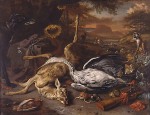
Jan Weenix is a Dutch painter from the late 1600s.[i] Similar to his father’s style, Jan Baptist Weenix, Weenix is known for painting dead game.[ii] This gruesome style (by present day standards) was quite common for still-lifes during that time period. The modern day perspective must consider this painting with historical context. In Still Life with Hunting Trophies, there seems to be a theme of human interference and exploitation with nature, based on the two perspectives.
Born in Amsterdam to an artistic family, Weenix studied in Utrecht. There were several members of his family who were known for painting still lifes. Although many consider his father (Jan Baptist Weenix) to be more famous, Weenix enjoyed a degree of success as evidenced by his commissions to serve as a court painter. Signing his first painting at the age of 18, Weenix preferred to paint landscapes, flowers, figures, and especially hunting pieces.
In the late seventeenth century, hunting became a popular recreational sport for the wealthy. The affluent would often proudly show their dead game on the walls of their elaborate manors. This idea of displaying wealth through a hunting scene became an opportunity for those with less money. To make up for the absence of a large estate, the less rich could at least have a painting of a large estate. Painters such as Weenix could create these still lifes, involving a bountiful hunting party on a massive estate, and sell them to the middling classes. Hunting, a very aristocratic activity, was a sign of wealth.[iii] The Dutch paintings, such as this one, reflected increasing prosperity for those who did not belong to the aristocracy. Originally hunting was reserved for the nobility but these hunting paintings were brought into lesser homes of the bourgeois.
Weenix helped revolutionize the setting for still lifes. Many painters in the late 1600s painted dead birds, rabbits, greyhounds, and deer in the kitchen and or market. Weenix, on the other hand, abandoned the market setting and painted hunts in gardens and estates. This included the killing process and the affluence of the nobility’s recreational sport. Soon afterwards, many of the painters would include the hunting scene in a setting adorned with wildlife and many kinds of vegetation. This also included elaborate forests and bouquets of large flowers.
The interference of humans and nature is clearly illustrated when one observes Weenix’s painting. However, historical context must be taken into consideration when analyzing the tone of the piece. There are several aspects in the painting that lead one to believe the scene takes place in the wild. The exotic setting includes wild flowers, grape vines, and an angry monkey baring his teeth. Furthermore, there are several animals, including various species of large birds and deer. These foreign items most likely represent elite possessions rather than an exotic setting. Objects such as fruit and monkeys show status and power. In the late 1600s Europe was just embarking on colonialism and imperialism, which is arguably reflected in this painting. This means the setting acts as a metaphor for man’s control over wildlife and other primitive populations. The painting clearly says that Europe has access to global trade. To add to the disturbing nature of the hunting party, there is a red sky in the background, hinting to the violent tone. Again, a modern day perspective may see these factors as bold and gruesome details, but historical context shows otherwise. Weenix’s decision to have the exotic animals lying dead in the very center is a bold way of showing humanity’s growing power over other living things.[iv]
The animals are dead due to a hunting party, clearly represented by the humans and hunting dogs in the background. Several of them are attacking a deer, which is a clear example of the theme of interference. The humans are interrupting the animals’ natural habitat and taking their lives. In the front of the painting, one’s eye is drawn to the deer that lies dead, with his tongue out and his fur ruffled. Additionally, the birds are sprawled across the ground, lying right next to a gun.
Based on the scene, a modern day perspective can conclude that the humans’ barbaric actions have negatively affected the natural state of this habitat. The painting arguably suggests that society can take nature on by force and have the power to dominate wildlife. In this particular example, animals fall under the umbrella of nature. Humanity has decided to act on the otherwise peaceful environment. The motive for hunting, be it recreational or for survival, can be interpreted in several ways. Whether the tone is in favor of killing animals for sport or not, it is still reasonable to believe that the humans are playing a major role in this habitat.
Despite the animals’ opposition, as evidence of the deer jumping on his hind legs, humanity seems to be the winning the battle in this painting. Many of the paintings with this style clearly represent humanity’s dominance over the free world. The high class act of hunting further implements the theme of human dominance over nature.
CC
[i] Jennifer M. Kilian. “Weenix.” Grove Art Online. Oxford Art Online. 28 Mar. 2011 <http://www.oxfordartonline.com/subscriber/article/grove/art/T090961pg1>.
[ii] Jennifer M. Kilian. “Weenix.” Grove Art Online. Oxford Art Online. 30 Mar. 2011 <http://www.oxfordartonline.com/subscriber/article/grove/art/T090961pg2>.
[iii] Scott Sullian. The Dutch Gamepiece. (The Boydell Press 1984. 33-35)
[iv] Fred Meijer. The Collection of Dutch and Flemish Still-life Paintings Bequeathed. (waanders Publishers)